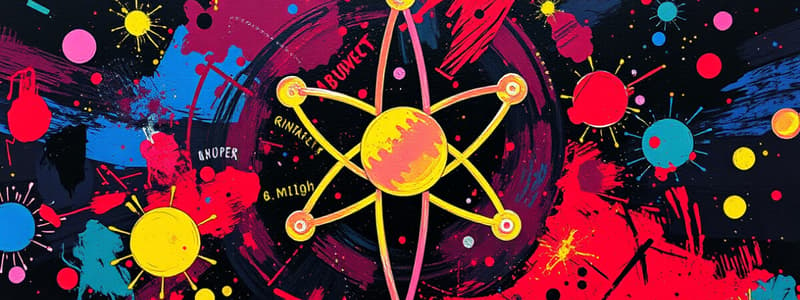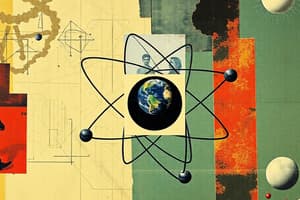Podcast
Questions and Answers
What is the charge of a neutron?
What is the charge of a neutron?
- Positive charge
- Negative charge
- Neutral charge (correct)
- Variable charge
If an atom has an atomic number of 8 and a mass number of 16, how many neutrons does it contain?
If an atom has an atomic number of 8 and a mass number of 16, how many neutrons does it contain?
- 24 neutrons
- 8 neutrons (correct)
- 8 neutrons (correct)
- 16 neutrons
Where are electrons located in an atom?
Where are electrons located in an atom?
- In the nucleus
- Within neutron shells
- In the proton cloud
- In specific energy levels around the nucleus (correct)
What defines the atomic number of an element?
What defines the atomic number of an element?
What is the mass number of an atom with 15 protons and 10 neutrons?
What is the mass number of an atom with 15 protons and 10 neutrons?
How many valence electrons does aluminum (Al) have?
How many valence electrons does aluminum (Al) have?
Which of the following correctly defines an ion?
Which of the following correctly defines an ion?
What is the mass number of an element with 20 protons and 20 neutrons?
What is the mass number of an element with 20 protons and 20 neutrons?
What type of chemical formula results from combining calcium ion (Ca²⁺) and chloride ion (Cl⁻)?
What type of chemical formula results from combining calcium ion (Ca²⁺) and chloride ion (Cl⁻)?
Which of the following correctly distinguishes a compound from a mixture?
Which of the following correctly distinguishes a compound from a mixture?
Which of the following molecules contains more than one type of atom?
Which of the following molecules contains more than one type of atom?
What is the electron configuration for argon (Ar)?
What is the electron configuration for argon (Ar)?
In Bohr's model, which statement is true regarding atomic structure?
In Bohr's model, which statement is true regarding atomic structure?
Flashcards are hidden until you start studying
Study Notes
Sub-atomic Particles
-
Protons:
- Located in the nucleus of the atom
- Charge: +1 (positive)
-
Neutrons:
- Also found in the nucleus
- Charge: Neutral (no electric charge)
-
Electrons:
- Orbit around the nucleus in specific energy levels or shells
- Charge: -1 (negative)
Atomic Number and Mass Number
-
Atomic Number (Z):
- Represents the number of protons in the nucleus
- Identifies a chemical element uniquely (e.g., Carbon has Z = 6)
-
Mass Number (A):
- Total number of protons and neutrons in the nucleus
- Calculated using the formula: A = Z + N (where N is the number of neutrons)
Calculating Protons, Neutrons, and Electrons
- Number of Protons (p): Equal to the atomic number (Z)
- Number of Neutrons (n): Calculated by n = A - Z
- Number of Electrons (e): Equal to the number of protons in a neutral atom
Valence Electrons and Electron Configuration
-
Argon (Ar):
- Atomic number: 18
- Electron configuration: 2, 8, 8
- Valence electrons: 8
-
Aluminum (Al):
- Atomic number: 13
- Electron configuration: 2, 8, 3
- Valence electrons: 3
-
Oxygen (O):
- Atomic number: 8
- Electron configuration: 2, 6
- Valence electrons: 6
Atomic Structure from Bohr’s Model
-
Element with Z = 20:
- Mass number (A): 40
- Protons: 20
- Neutrons: 20
- Electrons: 20
-
Element with Z = 11:
- Mass number (A): 23
- Protons: 11
- Neutrons: 12
- Electrons: 11
Distinctions Between Atoms, Ions, Molecules, Compounds, and Mixtures
-
Atoms:
- Smallest unit of an element retaining its chemical properties
- Example: Hydrogen (H), Carbon (C)
-
Molecules:
- Two or more atoms bonded together
- Same element example: Oxygen (O₂)
- Different elements example: Water (H₂O)
-
Ions:
- Atoms or molecules with a net electrical charge due to loss or gain of electrons
- Cations: Positively charged (e.g., Na⁺)
- Anions: Negatively charged (e.g., Cl⁻)
-
Compounds:
- Formed by chemically bonded different elements
- Unique properties compared to individual elements
- Example: Sodium chloride (NaCl), Carbon dioxide (CO₂)
-
Mixtures:
- Combination of two or more substances that are not chemically bonded
- Components retain individual properties
- Example: Saltwater (homogeneous), Sand and iron filings (heterogeneous)
Writing Chemical Formulae
-
Atoms:
- H₂O: Two hydrogen atoms + One oxygen atom
- CO₂: One carbon atom + Two oxygen atoms
-
Simple Ionic Compounds:
- Ca²⁺ + Cl⁻ → CaCl₂
- Mg²⁺ + Br⁻ → MgBr₂
- Al³⁺ + S²⁻ → Al₂S₃
-
Polyatomic Ions:
- Interaction involves complex ions with multiple atoms that carry a charge.
Studying That Suits You
Use AI to generate personalized quizzes and flashcards to suit your learning preferences.




